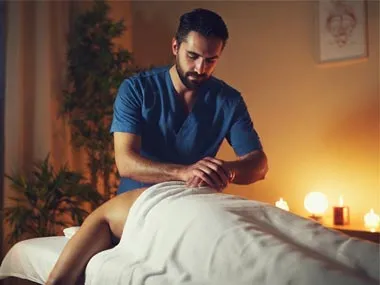
Long before modern medicine, acupressure was already healing bodies. Originating from traditional Chinese medicine, acupressure involves applying firm yet intentional pressure on specific points of the body. These points, known as acupressure points, are believed to correspond to internal organs and energy pathways (meridians).
Unlike acupuncture, acupressure requires no needles. Instead, it uses fingers, thumbs, elbows, or massage tools to stimulate healing, relieve pain, and restore energy flow.
Whether you're battling chronic fatigue, headaches, or emotional imbalance, acupressure massage might be the non-invasive answer you didn't know you needed.
If you're curious to explore more massage types, start with our massage styles overview.
How Does Acupressure Work?
The human body holds acupressure points across its surface — especially concentrated in the feet, hands, neck, and back. When these points are triggered, they can send signals through the central nervous system, release muscle tension, stimulate endorphins, and improve blood flow.
For example, applying pressure on the LI4 point (located between the thumb and index finger) is known to help relieve headaches and stress. Meanwhile, acupressure points in the feet can target internal organs like the liver, kidneys, and stomach.
Every session is different, depending on your body's needs. Therapists often combine acupressure with Swedish or deep tissue massage to personalize the experience.
The Healing Benefits of Acupressure Massage
People often turn to acupressure when other treatments fail. Why? Because it works on multiple levels — physical, emotional, and energetic.
Benefits include:
- Natural pain relief (headaches, back pain, joint stiffness)
- Improved sleep and digestion
- Reduced anxiety and emotional tension
- Boosted immunity and energy levels
- Balanced hormonal function
- Support during nausea and migraines
Unlike pharmaceuticals, acupressure has no side effects. It's drug-free, needle-free, and completely non-invasive.
6 Key Areas Where Acupressure Points Make a Difference
- Feet: Stimulates digestion, detoxification, and organ function
- Hands: Influences respiratory, colon, and headache relief
- Neck and Shoulders: Releases built-up tension and fatigue
- Lower Back: Eases sciatica and menstrual cramps
- Scalp and Temples: Supports clarity and relaxation
- Wrists: Helps alleviate nausea and motion sickness
Activating just a few of these areas can shift your entire mood, posture, and mental state. To combine this with other calming methods, explore aromatherapy sessions as well.
Is Acupressure Right for You?
Whether you're stressed, tired, or recovering from emotional burnout, this therapy adapts to your body.
It's ideal for:
- First-time massage clients who want something gentle yet effective
- Anyone recovering from illness or trauma
- Clients sensitive to deep pressure techniques
- Those looking for mental clarity and mood balance
- Athletes needing recovery without muscle fatigue
Sessions are tailored. Some therapists use slow, grounding pressure. Others use rhythmic pulses that awaken the body's natural response systems.
Acupressure vs. Acupuncture: What's the Difference?
While both techniques target the same meridians, acupuncture uses thin needles to stimulate energy flow, while acupressure uses physical pressure.
If needles make you uneasy, acupressure provides similar benefits — without the invasive aspect. According to Wikipedia, both methods are based on traditional Chinese medicine principles, but acupressure is far more accessible and relaxing for many.
Explore our masseur directory to find practitioners skilled in acupressure and other healing arts.
Common Myths Debunked
Myth: Acupressure is painful.
Truth: Done right, it feels firm but relieving — never aggressive.
Myth: You need to believe in energy flow for it to work.
Truth: Scientific research has shown that pressure on certain points stimulates the nervous system regardless of belief.
Myth: It's only for physical problems.
Truth: Acupressure helps with emotional issues like anxiety, insomnia, and overwhelm.
Myth: It's outdated.
Truth: Thousands still use it worldwide, and it's backed by institutions like the National Institutes of Health and Mayo Clinic for pain and nausea management.
5 Common Questions About Acupressure Massage
What should I wear during an acupressure massage?
Loose, comfortable clothing is best. Some therapists work through fabric, while others may ask you to disrobe partially — always with consent.
Can I do acupressure on myself?
Yes. Self-acupressure is safe and effective for common problems like tension headaches and fatigue. However, professional sessions deliver more consistent results.
Is acupressure suitable for elderly people?
Absolutely. In fact, it's often recommended for seniors due to its gentle nature and whole-body benefits.
How long is a session?
Typically 60 to 90 minutes, but shorter sessions focused on specific complaints (like migraines or digestion) are available.
Can acupressure help with fertility or hormones?
Many clients report hormonal balance, reduced PMS symptoms, and better menstrual cycles after consistent sessions. While it's not a cure-all, it supports overall endocrine health.
The Verdict: Acupressure Works — Naturally
When your body speaks, acupressure helps you listen. Whether you're burned out, in pain, or emotionally blocked, this therapy provides a path back to balance.
It's ancient, but it's not outdated. It's gentle, but not weak. It doesn't mask symptoms — it encourages your body to do the healing.
If you're ready to explore the power of your pressure points, book your acupressure